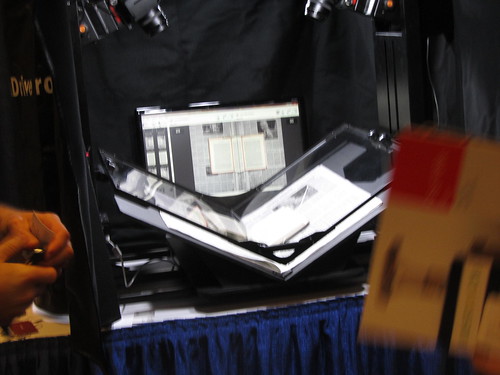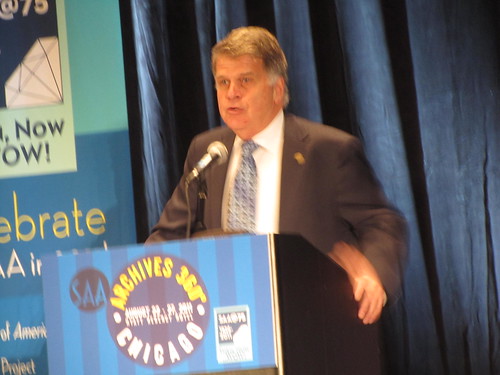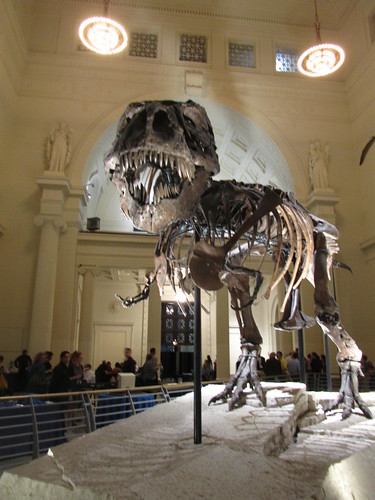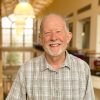This article is more than 5 years old.
I’m trying something new this year, and journeyed to the SAA “Archives 360” Conference in Chicago from August 25-28. This is new because I’m trying to become involved with a new national organization after exploring the Guild of Bookworkers in 2009-2010. I had corresponded with board members and officers of the Preservation Section of SAA beforehand, and so I was excited about the future with this great organization. Although SAA is geared toward archivists (as the name implies) they also focus strongly on a number of other areas like description, outreach and education, digitization and yes, preservation.
But first, let me digress a bit. On the flight to Chicago because of mechanical problems, I added to my nearly 100% flight bonking list by being inside the Atlanta Airport long enough to have both breakfast and lunch. I arrived in Atlanta at 8 am and departed at 1:40 pm. Here’s my flight record (and although it’s impressive, although I know it can be topped by several ZSR staffers):
2006-last leg of my flight cancelled, stranded in Charlotte; 2008-flight cancelled, spent the night in the LaGuardia baggage area; 2009-flawless!; 2010-last leg of flight cancelled, able to get on standby flight. This brings us to today. Enough said.
After I arrived at the conference, I attended the opening of the exhibits and poster sessions. I had a good talk with Nick Warnoc, President of Atiz, our book scanner company. Their new model is almost identical to the Internet Scribe machines I saw at the Library of Congress, with better cameras and lights, and a monitor behind the scanning platform.
The poster sessions were great with many tackling the preservation of born digital materials. I also had a good conversation with one poster presenter who used Archive-it at Michigan State-we’re shared stories of our mutual issues fine tuning the seeds for our crawls.
The most unique poster was an oral history project with New York city taxi drivers.
Friday morning, I started at 7 am with a “Write Away”- an introduction to all the writing opportunities SAA has to offer. Mary Jo Pugh, the SAA Journal editor was impressive when she stated the SAA Journal-American Archivist– was the oldest and largest circulating journal in the English language. They want articles dealing with their 3 goals: advocacy, diversity and technology. In addition, Peter Wosh, their Print and Electronics Editor spoke about their publications and advised folks to hang in there through the editorial review process.
The Plenary speaker was David Ferriero, the Archivist of the United States.
He briefly described the damages caused by the earthquake last week to areas around DC-which was minimal. I feel bad for them that following the earthquake, they have to face Hurricane Irene. Ferriero named three challenges for archives into the future:
1. Quantity-Born-digital materials are coming towards everyone. At the National Archives, they got 240 million emails alone from the Bush administration.
2.Format challenge-discarded formats and software(DOS, Netscape for example) and hardware which have content are a challenge to collect and preserve.
3.Social media- Facebook has one trillion page views in June, 2011 alone.
Following Ferriero, SAA President Helen Tibbo spoke on the challenge of born digital materials. PIC Tibbo said that a flood of digital content is outstripping our storage capacity. She said the OCLC Report identified 3 issues in Special Collections into the future:
1.Space
2.Born-digital material
3.Digitization
The lack of training in the area of preserving born digital materials (digital preservation) is a problem as most professionals are only trained in handling paper-based materials. SAA is responding to this by announcing a Digital Archives Specialist Certificate. This is a brand new program which I’m sure will get lots of interest. Beyond this point, Tibbo advised everyone to do something to advance their skill and knowledge this year.
The session on “Practical Approaches to Born Digital Electronic records was packed with folks on the floors and standing in the back. Think this topic was a popular one? A panel of speakers discussed their individual take: Suzanne Belovari, Tufts University, discussed her projects and the conversations needed with donors about their ‘hybrid’ collections-or those with both print and electronic content-and the need for backup and weeding. Suzanne has been working with the panel moderator, Christopher Prom using some of his tools. Ben Goldman, American Heritage Center at the University of Wyoming, made the statement that many collections are “undermanaged, undercounted and inaccessible.” Ben advocated for “secure and redundant storage and likened our container records to items in a box. Ben described a thorough process for processing electronic records including a virus check, running various reports to insure no harm came to these records. Melissa Salrin, University of Illinois, uses Firefly to scan incoming digital files for credit card or Social Security information, and maintains a “Preservation file” for masters of each individual record. Laura Carroll, of the Salman Rushdie Archives at Emory, described the abundance of electronic records they received from Rushdie. This included not only the files, but several generations of Mac computers (which they use). The Rushdie material included a substantial amount of born digital material and had huge privacy issues. Duke’s Seth Shaw was terrific. He is the brains behind the Duke Data Accessioner. Seth, a natural speaker, asked these questions for born digital/electronic records:
1.What are you providing access to (what form of electronic file-bitstream, emulated environment, etc.)
2.What do your users need or expect?
3.What can you actually do?
Seth basically feels you should “do something” and if it’s a little off, you can fix it later. Waiting until things are perfect is not his way.
Rebecca, Audra and I chatted with Seth after the session.
In the evening, we were treated to a reception in the Field Museum.
Although I attended other session on Archivists’ Toolkit (where Rebecca Peterson did a wonderful job explaining her collaboration with Audra Yun and Carolyn McCallum) and Exposing Hidden Collections Through Collaborations and consortia (where Audra Yun did a great job as a panel moderator), I want to talk about the Preservation Section meeting I attended.
As I mentioned earlier, I want to become involved in the Preservation Section. At the meeting, I was rewarded by a second talk by the Archivist of Congress, David Ferriero, who spoke on Collections Security. Following Ferriero, a panel spoke on collections security. They were Diane Vogt-O’Connor (Library of Congress), Larry Evangelista and Richard Dine (National Archives) and Brittany Turner (a private security consultant). The bulk of the talk was centered around a news-breaking theft involving multiple institutions along the I-95 corridor. Two men, Barry Landau (a Presidential historian and collector) and Jason Savedoff have stolen materials from libraries using the diabolical means of also stealing the catalog records, so as to cover their tracks. The two men were observed in one of the University of Maryland Libraries taking a historical document. When apprehended, over 60 documents were found in a library locker the two had. A search of Landau’s apartment yielded an array of historical documents, including a letter from Benjamin Franklin to John Paul Jones. Fascinating cloak and dagger stuff! NARA has implemented a Collections Security team and a series of training videos for their staff on the heels of this case. Following this session, I met the new president of the Preservation section, Jennifer Waxman and renewed my interest in volunteering for one of their committees. Encouraged, I trotted off.
SAA was productive, educational, and a friendly gathering that I hope to attend again. Thanks to Lynn for making this trip possible.

2 Comments on ‘Society of American Archivists- Archives 360’
Very interesting post, Craig! The collections security story was chilling. Thanks for sharing (loved the pictures!).
Sounds like it was a worthwhile conference for you in a number of ways. Good report, Craig!